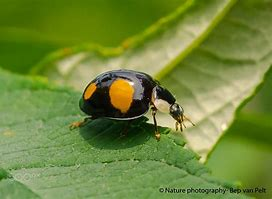Lady Beetles (Coccinellidae)
Lady
Beetles (Coccinelidae)
This
week I am going to talk about Coccinellids. This family consists of lady
beetles or more commonly known as ladybugs and ladybirds (in the UK). There are
more than 480 described lady beetle species in North America and about 6,000
species in total (Eaton 2007). Adult lady beetles are oval in shape and range
in length from 1 to 10 mm. They are dome-shaped dorsally and mostly flat
ventrally (ISU 2003). These beetles, like many others, have membranous wings
folded underneath their elytra. Adults' lady beetles of some species are
brightly colored ranging from yellow to red (Mizell 2000). They can be found
with a large number of dark spots or without spots depending on the type. Other
species have dark colorations with varying numbers of bright spots like the one
pictured below.
Lady beetles are predaceous meaning that kill other insects
for food. They often feed on aphids and other small insects. They are able to
capture these creatures because of their strong mandibles. There are a few
Coccinellidae species that do not feed on other insects but rather plant matter
such as leaves. This beetle family is holometabola meaning that the go through
complete metamorphosis. They develop from larva to pupa then finally to adults.
Lady beetles can be found in temperate regions as well as tropical regions.
This insect has been known to be an important biological control when it comes
to pests.
They are important because the prey on aphids and other
invasive pests. They have often been introduced to nonnative areas, which is
where their benefits have been most noticeable. This method of pest
control is also good because Lady beetles are relatively cheap. People can buy
this insect in large quantities without spending a lot of money. They
themselves, however, can also become troublesome. Since some non-native species
have been introduced to North America they have become pests, invading homes
once the summer season has passed.
These beetles also hold value in culture. They
are seen as different spiritual symbols for many different cultures. They have
been seen as lucky or signs of love and fertility (Pamela Anne). Because of
this common idea many people enjoy seeing these insects and are often likely to
release them after they’ve been caught.
I find lady beetles interesting because of how often I saw them as a little
girl. Most of the time I would find bright red ones with multiple black spots
but now that I am collecting insects, I’ve found some with different
colorations. The most recent lady beetle I found was orange with 3 yellow
ringed black bands. It also has a white spot on its head. After doing some
research I identified this beetle as a three banded lady beetle. The scientific
name for this insect is Coccinella trifasciata. This specific
beetle can also be yellow orange with black bands. I found this lady beetle on
an oak tree branch most likely near its home. They are often found in meadows,
gardens, and shrub like vegetation (Vermont Atlas of Life). This lady beetle
pictured is a female based on the black head with 2 pale spots.
Eaton, E. R., Bowers, R., & Kaufman, K.
(2007). Kaufman Field Guide to insects of North America. Houghton
Mifflin Co.
Eric VinjeEric Vinje founded Planet Natural with
his father Wayne in 1991. (2022, April 20). How to use and release
Ladybugs. Planet Natural. https://www.planetnatural.com/ladybugs-pest-control/
Iowa State University. (2003).
Family Coccinellidae - Lady beetles. BugGuide.Net. (n.d.).
https://bugguide.net/node/view/179
Mizell, R. F., & Frank,
J. H. (2000). Featured Creatures. Ladybugs - Insecta: Coleoptera:
Coccinellidae. https://entnemdept.ufl.edu/creatures/beneficial/lady_beetles.htm
Pamela Anne. (n.d.). What
Ladybugs Mean – in Love, Luck, Signs, and Symbols – with Chart. Ladybug
Planet. https://ladybugplanet.com/what-ladybugs-mean-love-luck-signs-symbols/
Vermont Atlas of Life.
(n.d.). Three-banded lady beetle (Coccinella trifasciata) Linnaeus 1758.
https://val.vtecostudies.org/projects/lady-beetle-atlas/three-banded-lady-beetle/




Comments
Post a Comment